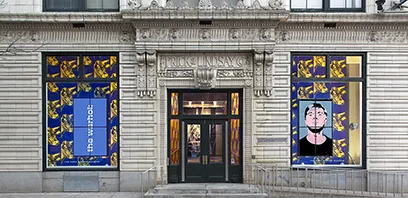Home
Museums
Back
Issues
Membership
Was T.rex a predator
or a scavenger? Scientists still dont know, but you can draw your own
conclusions as you study the scene depicted in the mural. Did the dinosaur
in the foreground kill what hes eating, or did he find it already dead?
Will the oncoming T.rex pose a threat? Will they fight over the carcass?
You decide.
By Kathryn M. Duda
The more scientists study dinosaur fossils,
the more they learn about how these kings of the Mesozoic lived
and died.
In the past decade these fossils have moved the science of paleontologyand
our understanding of life processes–ahead by light years.
Carnegie Museum of Natural History
reflects the latest discoveries by incorporating them into its exhibits
and programs. Gone is the old, scientifically incorrect T.rex wall painting
in Dinosaur Hall, replaced by an accurate and visually stunning mural nearby.
The hall features a dramatic sound and light show every hour, a robotic
tour guide, and interactive computer games. You can examine a fossil that
flew aboard the space shuttle in 1998, watch scientists extract fossils
from a bed of rock, and see a replica of the largest flying animal ever
known to exist. In March, a world-renowned scientist speaks about the end
of the dinosaur era, and this summer were installing a life-sized model
of Diplodocus on Forbes Avenue. This is the place where dinosaurs come
back to life.
Walter Alvarez Explains the Crater of
Doom
-Free Lecture March 8 in Carnegie Lecture
Hall-
Its been over a century since scientists
uncovered the evidence that dinosaurs ruled the animal kingdom during the
Mesozoic era, and weve been fascinated ever since. But what happened to
the dinosaurs? Why did they disappear?
In the early 1990s, scientists announced
a startling theory: Dinosaurs, and many other life forms, perished as a
result of a giant asteroid that crashed into the Earth 65 million years
ago.
Geologist Walter Alvarez was at the
forefront of the research that led to this astounding theory. Over the
course of two decades, Alvarez pursued the question of the dinosaurs demise,
making discoveries of his own and synthesizing those of other scientists.
His theory is this:
The asteroids impact, packing a wallop
equal to that of 100 million hydrogen bombs, ripped apart whole forests,
and it shook the surrounding land so violently that huge submarine landslides
and giant tsunami resulted. Most of North America was reduced to a desolate
wasteland within hours, but the other continents were not spared for long.
The cloud of roiling debris that the impact produced blackened the sky
for months all around the world, leading to a collapse of the food chain
and the eventual death of most Mesozoic life forms, including the dinosaurs.
How does a scientist prove such a scenario?
It wasnt easy. The 20-year struggle to piece it together included searching
for signs of iridium produced by the asteroids impact; chasing down leads
that eventually proved incorrect; deflecting skeptics; a 10-year search
for the impact crater; questions of oceanic or continental impact, decisions
about one or multiple craters, or instant or gradual disaster.
But as compelling as it is, the Alvarez
theory is not accepted in all scientific circles, especially among vertebrate
paleontologistsscientists who study the fossil remains of animals with
backbones, including dinosaurs.
A great many vertebrate paleontologists
accept the idea of a meteorite impact, says Mary Dawson, curator of Vertebrate
Paleontology at Carnegie Museum of Natural History. But scientists are
still not completely satisfied that this is the answer to why dinosaurs
disappeared. Reasons for this skepticism include the fact that many animalsincluding
crocodiles, turtles and mammals–survived the impact, and perhaps dinosaurs
could have as well. Also, many dinosaurs had died out before the end of
the Mesozoic as part of the natural evolutionary process.
So why did the Mesozoic dinosaurs all die
out around the same time? Dawson offers two theories: because of a climatic
cooling (unrelated to the meteorite); or perhaps because of the proliferation
of flowering plants, which have a different biological make-up than the
plants herbivorous dinosaurs fed upon.
While no single theory on the end of the
dinosaurs has yet been accepted as definitive, Alvarez crater of doom
theory has made a lot of scientists sharpen their skills in looking at
that interval between the Mesozoic and the Cenozoic, Dawson says. Dont
miss hearing one of the most renowned scientistsWalter Alvarez–explain
his theory on March 8. The lecture is co-hosted by Carnegie Mellon University
and Carnegie Museum of Natural History.
Member Tip
Alvarez riveting tale is explained
fully in his book, T.rex and the Crater of Doom, on sale in the Natural
History Store. Use your member card for a 10% discount!
New Mural Shows T.rex in a New Light
Scientists are agreed: theropods-two-footed
carnivores like T.rex–are ancestors of modern birds. And that theory has
led to new insights about the biology of theropodsscientists are now rethinking
how these stood, moved and ate.
Some of these recent discoveries are reflected
in the new mural in Dinosaur Hall, a dramatic color rendering by Michael
Skrepnick, one of the most sought-after dinosaur artists in North America.
In the Skrepnick mural, T.rex assumes the more horizontal posture that
we now believe to be correct.
The horizontal posture is considered more
accurate because new studies of the T.rex skeleton show this is how the
bones fit together, says Carnegie paleontologist Chris Beard. He says
the biggest advance in showing that T.rex walked horizontally is the theory
that theropods are related to birds.
The new posture of T.rex is not different
from that of a blue jay at a bird feeder, he adds.
Half a century ago, scientists didnt know
that theropods were related to birds, and they thought the bones fit together
another way, resulting in a vertical stance. That tells you theres some
flexibility in thinking about various aspects of dinosaur biology, Beard
says.
The natural surroundings of T.rex are on
display as well, as the mural shows what scientists now believe to be an
accurate portrayal of eastern Montana 66 million years ago. It was a sub-tropical
coastal plain in those days, with an inland seaway called the Cannonball
Sea that extended from the Gulf of Mexico up into Canada. Look closely
and youll see something familiar–a pond turtle, the artists reminder
that some dinosaur-era flora and fauna are still part of the Earths biodiversity
today.
Largest Flying Reptile: Quetzalcoatlus
The largest animal that ever flew–Quetzalcoatlus
northropihas landed at Carnegie Museum of Natural History. With a wingspan
of 36 feet, this gigantic pterosaur now hovers high above the dinosaur
specimens like it did in the late Cretaceous period some 80 million years
ago.
The model features a skeleton cast
with a muslin covering that gives visitors an idea of the animals imposing
wingspan. Visitors can immediately understand that T.rex was not by any
means the only big player during the Cretaceous.
Carnegie paleontologist Mary Dawson
says the skeleton from which this model was cast was a rare find, because
Quetzalcoatlus bones are fragile and are rarely discovered in good condition.
Carnegie Museum of Natural History is the first to exhibit a complete specimen
in a flying posture.
The extensive restoration work done
on the original skeleton for this project has caused scientists to take
another look at how pterosaurs flew, Dawson says. Theyve discovered that
these creatures flew differently than birds do, with the wings supported
by an elongated finger. Also, pterosaurs probably used their wrists to
fly, she adds. It is possible that more information on pterosaur flight
will be uncovered as scientists continue studying this specimen.
Quetzalcoatlus northropi was found in
southern Texas on the Canonball Sea, the same waterway at which T.rex is
shown in the new Dinosaur Hall mural above.
Look for Our Dinosaur on Forbes Avenue
Diplodocus carnegeii, the giant 12-ton dinosaur
whose fossil bones made Carnegie Museum of Natural History famous, is going
to step outside the building and show itself in the flesh. Or at
least in fiberglass. A life-size replica, about 90-feet long
and 15- to 18-feet high at the hips, will be installed this summer at the
corner of Carnegie Institute and Library near Forbes Avenue and Schenley
Drive. Oakland will get an unforgettable one-of-a-kind landmark that
symbolizes the great changes taking place at the museum.
Called Dippy by Andrew Carnegies friends,
Diplodocus has been the museums signature exhibit ever since Andrew Carnegie
had the fossil bones that were discovered in Wyoming in 1899 delivered
to Pittsburgh and mounted in his new museum.
Carnegie enjoyed presenting casts of Diplodocus
to museums around the world. He boasted about Americas scientific progress,
and his own institutions pre-eminence in research. In 1904 he honored
the King of Englands request to have one at the British Museum, and he
kept on giving to presidents, kings and emperors, for installation in other
national museums. By 1913 he had given replicas to natural history
museums in Germany, France, Austria, Italy, Spain, Russia and Argentina.
Mrs. Carnegie sent a replica to Mexico in 1930, and another set of cast
bones was sent to Munich in 1934 (but not erected). The casts were
re-used to make molds for Dinosaur National Monument in Utah, but by then
had reached the end of their useful life. As far as we know, the
fossil skeleton of Dippy is still a must-see exhibit in nine of the worlds
greatest natural history museums.
Science now has new information about the
behavior of Diplodocus. Dippy is thought to be a browser of understory
plants, so our replicas neck will be more horizontal than before. The
long tail probably balanced its long extended neck, and so the tail will
be raised off the ground. The bronze-colored giant who greets the
public on Forbes Avenue will be the most lifelike Diplodocus science can
create.
–R. Jay Gangewere
Copyright
(c) 1999 CARNEGIE magazine All rights
reserved. E-mail: carnegiemag@carnegiemuseums.org



